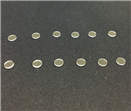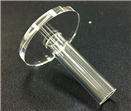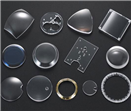

Time:2025-06-26
Sapphire glass, as an artificially synthesized high-performance material, has shown extensive potential for applications in multiple fields due to its physical and chemical properties. The complexity of its manufacturing process, as well as factors such as transparency, color, and processing accuracy that need to be considered when selecting, together constitute the unique technical charm and market value of this material.
The main component of sapphire glass is aluminum oxide (Al ? O ∝), with a Mohs hardness of 9. This high hardness characteristic makes sapphire glass highly scratch resistant and wear-resistant, making it an ideal choice for smartphone screens, watch mirrors, and optical devices. However, high hardness also means an increase in processing difficulty. During the manufacturing process, special processing techniques and equipment such as laser cutting, precision grinding, and polishing are required to ensure the dimensional accuracy and surface quality of the product.
Transparency is another key characteristic of sapphire glass, which has high transparency in the ultraviolet, visible, and near-infrared spectral ranges. Its high refractive index range (1.75 to 1.77) endows it with high optical clarity and low absorption coefficient, making it important in high-precision optical devices, high-resolution displays, and optical sensor protective covers. When choosing sapphire glass, transparency is an important factor to consider, as it directly affects the optical performance and visual effects of the product.

In addition to transparency and hardness, color is also an aspect to consider when choosing. Although commonly used sapphire glass is colorless, various colors can be generated by adding different chemical elements. These colored sapphire glasses have unique value in decoration, art, and specific optical applications.
In terms of processing accuracy, the manufacturing process of sapphire glass requires high precision. Due to the hardness and brittleness of materials, traditional mechanical processing methods are often difficult to apply. Therefore, advanced technologies such as precision grinding, polishing, and laser processing are needed to ensure the dimensional accuracy and surface quality of the product. These processing procedures not only require highly precise control, but also require a deep understanding of material properties. In addition, the wear and tear of processing tools is also an issue that cannot be ignored. Due to its high hardness and wear resistance, the tool will suffer severe wear during the machining process, which increases machining costs and shortens tool life. Therefore, when choosing processing equipment and tools, it is necessary to consider their durability and efficiency.
In the application field of sapphire glass, the complexity of its manufacturing process and the factors that need to be considered when selecting have been fully reflected. In terms of smartphone and watch screens, their hardness and scratch resistance improve the durability and display effect of the devices. At the same time, its high transparency and low scattering also make the display effect clearer and more realistic. In terms of optical components, high transparency and low absorption coefficient make it an ideal choice for high-precision camera lenses, high-resolution optical systems, and optical sensors. In semiconductor equipment, it can be used as an insulating substrate and protective cover to ensure stable operation of the equipment in high temperature and high electric field environments.
The manufacturing process of sapphire glass is complex and requires high standards. When selecting, multiple factors such as transparency, color, and processing accuracy need to be considered. These characteristics together constitute the unique technical charm and market value of sapphire glass. In product applications, the characteristics of high transparency, impact resistance, wear resistance, and corrosion resistance have been fully utilized.






Tel
Mobile phone
Customer service
TOP